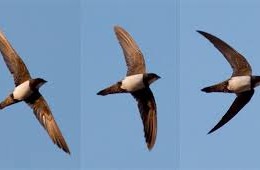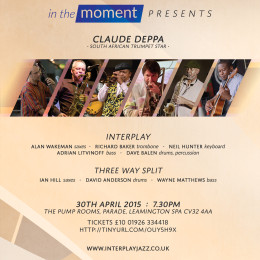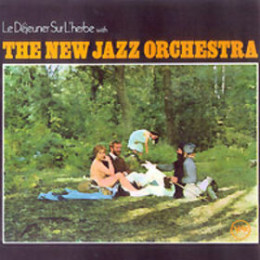Posted by Adrian Litvinoff on Oct 27, 2017
Interplay saxophonist Alan Wakeman recently reached a milestone birthday this year. Matthew D. Wright has written about his considerable track record and his continuing contribution to jazz, and this appraisal appeared recently in Jazzwise Magazine. http://www.jazzwisemagazine.com/breaking-news/14735-westbrook-and-wakeman-line-up-with-the-uncommon-orchestra-for-a-bigger-show Many Happy Returns...
See MorePosted by Adrian Litvinoff on May 12, 2015

May is eagerly awaited as the true start of summer – at least in this house – because it bring the return of the Swifts. Almost the last summer migrant birds to arrive, they animate the sky over towns and cities as well as over open country. The sight of them wheeling and darting high in the air is truly invigorating, while their screams as they swoop low around the roof-tops are an essential part of summer’s sound-scape. It was on May 5th that I saw my first swift this year, and now they are back in numbers. Amazing birds The more I understand about these birds the more amazing they appear. For example after fledging and leaving the nest a young swift may remain airborne for as long as three years before touching down to begin building a nest of its own! Feeding, drinking, sleeping, mating, all are done on the wing. ‘Sleeping’ is in fact hardly the correct term – somehow they are able to continue in flight for hours in a semi-comatose state, often at very high altitude, and well out of the range of predators. Nest-guests We live in a very old house, and have been thrilled to see swifts diving straight through a small opening into our roof-space on several occasions. We don’t know if they have bred there – there is no way for us to get up so high, let alone see inside. But we are happy to have them there, especially given that nesting sites have become much more scarce as construction methods have changed. Fortunately some house builders are beginning to recognise the importance of providing bird-friendly access to nest space in new developments, so hopefully this decline can be reversed. ‘Swift Return’ It is great to see the swifts back again, and to feel the year turning towards its summer peak. I feel a tune coming on! https://interplayjazz.co.uk/wp-content/uploads/2013/06/swift-return.mp3 If you want to hear the full track why not head over to Spotify and type in Interplay Global? You’ll be able to savour our whole album!...
See MorePosted by Adrian Litvinoff on Apr 11, 2015

I’ve been talking to jazz musicians and promoters in the Midlands a lot recently in the build up to International Jazz Day 2015 and our concert with Claude Deppa, Interplay and Three Way Split on April 30th at the Pump Rooms, Leamington. I’m struck by how few of them have heard of IJD, let alone are preparing to play any part in it. This could be a case of good old British scepticism about anyone who sets out to blow their own trumpet. If so I think this is misplaced, and risks letting an important opportunity go unanswered. As I see it IJD is a fantastic development for jazz, a music that has been marginalised and neglected for decades. It allows us to present the case for jazz in a totally new light – with the full public endorsement of UNESCO, a global organisation committed to the advancement of culture and education worldwide. Let’s look at this in a few headlines: Herbie Hancock, one of the most enduring and undisputed creative artists of the last 50 years, has been appointed to UNESCO as Ambassador for Intercultural Dialogue. And he is a jazz musician – one of our own. How fantastic is that! Herbie has not only succeeded in persuading UNESCO to instigate International Jazz Day (in 2011) but he has brought the resources of the Thelonious Monk Institute of Jazz in behind it, to ensure that there is capacity to promote and coordinate IJD worldwide. Look at the Jazz Day website to see what I mean. IJD is totally inclusive. There are hundreds of events ranging from concert hall presentations to community festivals, workshops and broadcasts, many contemporary in content but also going right back to the Preservation Hall Jazz Band (in Oman!) In many places jazz is being celebrated alongside indigenous and traditional music, truly in the IJD spirit of promoting intercultural dialogue and mutual understanding, and fostering international cooperation and communication. All this suggests to me that for at least one day a year the jazz world is setting the cultural agenda, not fighting for a place on it, and I love it. We know that jazz in the UK is under-exposed, under-resourced and poorly understood by many people and institutions. Despite that it survives, and some might say flourishes, as a music of persistence, of resistance against the homogenisation of culture, and the assertion of every individual’s right to be heard in their own way. Many people...
See MorePosted by Adrian Litvinoff on Mar 7, 2015

Jazz musicians learn and develop by listening as well as by playing. It doesn’t matter which starts first in my opinion, but I know that going to hear live jazz and exploring it on record and through radio have been vital aspects in my own musical growth. It has both excited me about the possibilities for my own music and taught me invaluable lessons of approach and execution. There may be exceptions – maybe – who have pursued a solitary path with originality and inventiveness. Even so they probably need other musicians to play with in order to fulfil their creative impulses, and in jazz ‘playing with’ has to mean ‘listening to’ in my book. What brings this to mind? I was recently the guest on Alan Musson’s excellent show ‘Jazz Kaleidoscope’ (The Bridge Radio) which afforded me the opportunity to choose almost two hours of music for the show. As you would expect, I spent a considerable time trawling through my CDs to put my playlist together. With so much to choose from I had to deal sternly with myself to arrive at a list that truly justified its selection. So what criteria carried the day? In the end there were two themes: one was to do with people crossing boundaries and playing in someone else’s yard. It’s more than ‘crossover’, which for me occasionally suggests cleverness without a further musical need or justification, like riding two bicycles at once. So for example ‘Hands’, Dave Holland’s collaboration with Spanish guitarist and head of Flamenco dynasty Pepe Habichuela; Dave confides in the liner notes that it took him a couple of years to work out what he should really play! Or Roland Kirk’s treatment of ‘Say A Little Prayer’, which expands a brilliant popular song into an anthem for Martin Luther King and all the tribulations of the African-American people, regretfully as relevant today as it was in the 1960s. The other strand was about me acknowledging those who inspired me, and whose creativity and artistry helped to illuminate my path as I was finding my way. This rather large number of artists comprises many American but also many British musicians. Thinking again about Jack Bruce, (see my post ‘Jack Bruce – Recollections and Reflections’) I was thrilled to rediscover on Gilles Peterson’s ‘Impressed Vol. 1’ the marvellous ‘Dejeuner Sur L’Herbe’ by the New Jazz Orchestra. Not only is Jack Bruce on double bass, helping to hold Neil Ardley’s superb...
See MorePosted by Adrian Litvinoff on Nov 13, 2014

This week Radio 6 Music is celebrating libraries, while indie band Everything Everything is hosting an arts festival in Manchester’s newly-refurbished Central Library. So it seems the perfect time to say my piece about libraries and the debt I owe them. At primary school aged 9 or 10 we were walked down the hill some 30 strong every week to the branch library in Keats Grove, where a kindly lady made us welcome and talked about the books and how they were arranged. Coming from a bookish family I was already a reader, and so the thing that really excited me was the catalogue. It dominated the middle of the room; tier upon tier of wooden cabinets containing draw after draw of index cards, each pointing to a particular book, all in alphabetical order. As I knew my alphabet I realised with a thrill that I could use it to look anything up in the catalogue and find whatever I wanted! Not only that, I would always be able to do this, because (I thought) libraries would always be here. I knew I had found a ‘skill for life’. Saturdays became a regular day for visiting the library. On our little bikes my brother and I would peddle off to Arkwright Road, or to Swiss Cottage, to change our books and explore what was waiting for us on the shelves. It was a liberating and fulfilling experience. We each had our own library membership; my first autonomous official transactions were taking books out and returning them, occasionally paying a modest fine. Leaving secondary school under a cloud (don’t ask!) I was fortunate to get a job in the record library at Swiss Cottage. What treasures! The first LPs I borrowed, Shelly Manne and His Men Live at the Blackhawk Vols 1 & 2, thrilled me with their vibrant, direct sound and the intensity of the band’s performance. I felt as if I was right there in the club in San Francisco! These albums became my touchstone for live jazz recordings, and live for me still. I was able to explore everything from Duke Ellington to Cream, Albert Ayler to the Incredible String Band and more. The librarian there responded to my interest and we discussed music all the time. He even asked me to suggest what to buy for the collection, and for a while we were staunch supporters of the Impulse! label. I felt for once that my musical tastes...
See MorePosted by Adrian Litvinoff on Nov 4, 2014

Many people were saddened by the recent death of Jack Bruce. Bassists in particular have reason to acknowledge his influence and his passing. I certainly do. As a young man and beginning bassist in London in the 1960s I had opportunities to hear many fine players, both of double bass and electric bass. Ron Mathewson, Chris Laurence, Dave Green, Danny Thompson, Jeff Clyne and Harry Miller were among my favourite jazzers. They were readily ‘available’ at club gigs around London. Listening to Jazz Club on the radio I grew to identify some players by their sound alone, because in those days bass amplification had yet to arrive. (When it did, for a while everyone sounded like ‘Mr. Polytone’ or ‘Mr. Underwood’, or whoever made the next pick-up.) And this was without all the great American players I was also into. On electric bass there were some fine players too – Alex Dmochowski swung like no other beside the drummer Aynsley Dunbar, but Steve York, John McVie and Cliff Barton also come to mind. In the midst of this, in 1966 Cream arrived and exploded my sense of everything that might be possible. This configuration of genuine musical equals challenged the hierarchy implicit within many rock and jazz groups. The openness and symmetry of their power-house sound seemed perfect, while their playing was so free and adventurous, nothing was beyond their musical reach. They seemed well able to justify the egotistical band name and the ‘first supergroup’ tag. ‘Fresh Cream’ was constantly on the turntable at home and at parties, with its audacious writing, use of voices as instruments, and dispensing with the bass on occasions to allow Jack to play harmonica. (Play it? – he used it as a means of assault.) Rhythmically rock-solid yet fluid and innovative, blues-infused without being limited in form, lyrically inventive and intelligent, the album had so much, and it promised more. At the Saville Theatre show in February 1967 that ‘more’ presented itself in its full live glory, and at the bottom of it all was Jack’s bass with ‘that’ sound. In his hands it spoke, it sang, it growled; it drove, it probed, it challenged; it said restlessness, and conviction, and ‘why not?’ Above all it rejoiced in itself without regard for previous ideas of what the role of the bass ‘should’ be. And yet I would misrepresent Jack’s impact to portray it solely in terms of his bass-playing, when...
See More







